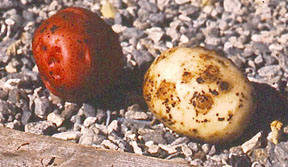 |
| Black scurf, or Rhizoctonia, is a fungal disease of potatoes. New research shows that it may be controlled by compounds released from mustard crops. Photo by Eric Sideman. |
by Eric Sideman, Ph.D.
If you have ever had lots of little black, irregular lumps on the skin of your potatoes that resemble soil but will not wash off, then you have seen black scurf. This is a disease that is caused by a fungus called Rhizoctonia solani. The black specks are just a cosmetic problem, in that they do not affect the eating quality of the potato. However, the disease has other symptoms. The fungus attacks the plant from the time the potato seed piece sprouts, and may kill sprouts, delay emergence or cause weak sprouts that never recover. (It is called Rhizoctonia canker when it causes stem lesions.) During midseason, if the year is rainy or humid, Rhizoctonia may develop into its sexual phase (Thanatephorus cucumeris), which forms a white, powdery mold just above the soil line that will weaken the plants.
The black specks are one of the ways the fungus reproduces. They are called sclerotia, which are tight, dry masses of fungal tissue (mycelium) in a resting phase. The fungus may also survive from season to season as mycelium growing on plant residue. In the spring the sclerotia germinate or the mycelium begins to grow again, and infection of the host begins. Most commonly, infection of potatoes is from planting potato seed pieces with sclerotia on them. Infection is favored by cool, moist soil. Once potato plants are larger and have leaves, infection of the stem is much less likely. New sclerotia form on mature tubers late in the season when the soil is cool and the vines senesce.
The fungus does not need the host potato every year; it can survive in soil as mycelium associated with most kinds of decomposing organic matter. So, what is generally the best disease management tool of organic farmers – crop rotation – is not very effective. In addition, sclerotia can survive for years without a host crop.
No single practice is likely to result in total control. Crop rotation of two to three years will certainly help. Obviously, planting seed tubers that are free of sclerotia is absolutely necessary. Recent work at the University of Maine suggests another promising method of control. Peter Sexton and his coworkers (Sexton et al., 2007) tested a brassica green manure crop, planted before the potato crop, that releases compounds that kill the sclerotia.
Brassica species have varying amounts of compounds called glucosinolates, and some species have a lot. In response to wounding, glucosinolates are hydrolyzed (broken down) by the enzyme myrosinase, releasing a range of products. Some of the volatile compounds that are released have a range of activity against various species of nematodes, insects, weeds, bacteria and fungi. One fungal species that is quite susceptible to these compounds is Rhizoctonia.
Sexton tested a mustard called ‘Caliente 119’ that has been effective in the Pacific Northwest. His team seeded this as a green manure crop, at 10 lbs./acre, with most plots planted in June. The crop was mowed at flowering and tilled into the ground, so the plant was growing for 30 to 90 days, depending on the plot. Remember, the green part of the plant has to be wounded (macerated, in this case) to signal it to release the compounds.
A significant reduction in black scurf was noted in trials with potatoes the following season. I definitely think that a mustard green manure could fit into many rotations aimed at reducing the incidence of black scurf. Planting mustard in June would leave time to seed a cover crop of hairy vetch and winter rye, for instance.
One complicating factor that Sexton noted was an increase in white mold in some plots in his study. Mustards and potatoes are both hosts of white mold, so if this disease is a problem in your system, you may not want to rotate with mustards.
Sexton, Peter, Andrew Plant, Steven B. Johnson and John Jemison, 2007. “Effect of a Mustard Green Manure on Potato Yield and Disease Incidence in a Rainfed Environment. Crop Management, Jan. 22, 2007. doi:10.1094/CM-2007-0122-02-RS, at https://plantmanagementnetwork.org/cm/element/cmsum2.asp?id=6007.

